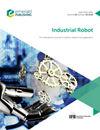一种新的工业机器人无传感器被动导通编程启动方法
IF 2.5
4区 计算机科学
Q3 ENGINEERING, INDUSTRIAL
Industrial Robot-The International Journal of Robotics Research and Application
Pub Date : 2022-05-27
DOI:10.1108/ir-02-2022-0034
引用次数: 1
摘要
无传感器被动导通编程(LTP)是一种很有前途的物理人机交互技术,可以实现基于重力和摩擦补偿的手动轨迹演示。LTP启动的主要难点在于静摩擦补偿。传统的方法只在关节速度超过阈值后补偿库仑摩擦,而不是静摩擦补偿。因此,常规启动外扭矩必须克服静摩擦。当静摩擦较大时,常规LTP难以启动并进行小的运动。本文旨在减小启动外转矩,提高小运动性能。本文揭示了高增益位置环在工业机器人应用中的一种新用途,旨在灵敏地检测启动过程中的外部扭矩。然后,通过库仑摩擦部分补偿静摩擦,以促进启动。此外,提出了一种基于有限状态机的启动和传统被动LTP之间的详细转换方法。在ROKAE XB4机器人上进行了实验,验证了所提出的外扭矩检测方法的有效性。与传统的LTP方法相比,所提出的LTP方法显著降低了启动外转矩,有利于小运动。本文提出并验证了一种基于启动外转矩检测和启动与传统LTP之间的过渡方法的无传感器LTP启动方法。本研究提高了LTP的启动性能,特别是对于具有较大静摩擦的工业机器人。本文章由计算机程序翻译,如有差异,请以英文原文为准。
A novel start-up method of sensorless passive lead-through programming for industrial robots
Purpose
Sensorless passive lead-through programming (LTP) is a promising physical human-robot interaction technology that enables manual trajectory demonstrations based on gravity and friction compensation. The major difficulty lies in static friction compensation during LTP start-up. Instead of static friction compensation, conventional methods only compensate for Coulomb friction after the joint velocity exceeds a threshold. Therefore, conventional start-up external torques must overcome static friction. When the static friction is considerable, it is difficult for conventional LTP to start up and make small movements. This paper aims to decrease the start-up external torque and improve the small movement performance.
Design/methodology/approach
This paper reveals a novel usage of a high-gain position-loop in industrial robot applications aimed at sensitively detecting external torque during start-up. Then, the static friction is partly compensated by Coulomb friction to facilitate start-up. In addition, a detailed transition method between the proposed start-up and conventional passive LTP is proposed based on a finite state machine.
Findings
Experiments are implemented on the ROKAE XB4 robot to verify the effectiveness of the proposed external torque detection. Compared with the conventional LTP method, the proposed LTP method significantly decreases the start-up external torque and facilitates small movements.
Originality/value
This paper proposes and verifies a novel start-up method of sensorless LTP based on a start-up external torque detection and a transition method between start-up and conventional LTP. This research improves the LTP start-up performance, especially for industrial robots with large static friction.
求助全文
通过发布文献求助,成功后即可免费获取论文全文。
去求助
来源期刊
CiteScore
4.50
自引率
16.70%
发文量
86
审稿时长
5.7 months
期刊介绍:
Industrial Robot publishes peer reviewed research articles, technology reviews and specially commissioned case studies. Each issue includes high quality content covering all aspects of robotic technology, and reflecting the most interesting and strategically important research and development activities from around the world.
The journal’s policy of not publishing work that has only been tested in simulation means that only the very best and most practical research articles are included. This ensures that the material that is published has real relevance and value for commercial manufacturing and research organizations. Industrial Robot''s coverage includes, but is not restricted to:
Automatic assembly
Flexible manufacturing
Programming optimisation
Simulation and offline programming
Service robots
Autonomous robots
Swarm intelligence
Humanoid robots
Prosthetics and exoskeletons
Machine intelligence
Military robots
Underwater and aerial robots
Cooperative robots
Flexible grippers and tactile sensing
Robot vision
Teleoperation
Mobile robots
Search and rescue robots
Robot welding
Collision avoidance
Robotic machining
Surgical robots
Call for Papers 2020
AI for Autonomous Unmanned Systems
Agricultural Robot
Brain-Computer Interfaces for Human-Robot Interaction
Cooperative Robots
Robots for Environmental Monitoring
Rehabilitation Robots
Wearable Robotics/Exoskeletons.

 求助内容:
求助内容: 应助结果提醒方式:
应助结果提醒方式:


